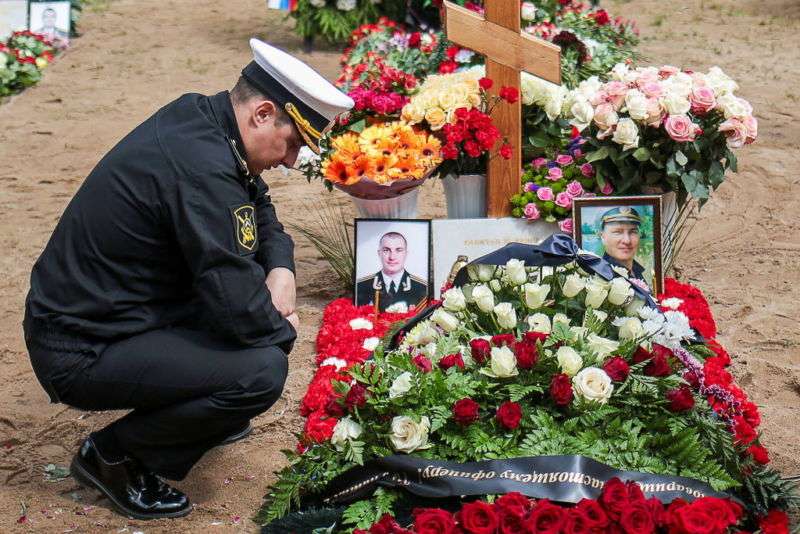
Russian spy sub crew prevented nuclear accident at cost of their lives

On July 1, 14 Russian sailors—most of them senior officers with ranks equivalent to captain, commander, or lieutenant commander in the US Navy—died in an accident aboard a small nuclear-powered submarine designed for operations near or on the sea floor. The submarine Losharik (named after a Russian children’s book character who is a horse made of juggling balls) was operating in the Barents Sea when the accident took place.
According to a Russian Navy statement published by TASS, the 14 “died in Russian territorial waters as a result of inhaling combustion products aboard a research submersible vehicle designated for studying the seafloor and the bottom of the World Ocean in the interests of the Russian Navy after a fire broke out during bathymetric measurements.” The officers died while combating the fire.
In a statement delivered on July 3 from the Russian North Fleet’s base in Severomorsk, Russian Defense Minister Sergei Shoigu said that three crew members and a civilian aboard the sub survived the disaster. The crew members who died, he said, “acted heroically in the critical situation. They evacuated a civilian expert from the compartment that was engulfed by fire and shut the door to prevent the fire from spreading further and fought for the ship’s survival until the end.”
The Kremlin has released a transcript of a meeting between Shoigu and Russian President Vladimir Putin. In it, Shoigu said that “we can repair the submersible quickly,” thanks to actions by the crew to seal off the nuclear propulsion systems of the sub from the fire. “The crew has taken the necessary measures to save the unit, which is in working order.” In other words, the actions of the officers who died fighting a fire from within a sealed compartment prevented an undersea nuclear disaster in the Arctic.
The accident is a public reminder of Russia’s very secretive operations in the Arctic, which Putin’s government has aggressively moved to protect militarily and exploit economically as the Arctic ice has retreated. Losharik has played a role in Russia’s efforts to counter US submarines’ covert incursions into their northern back yards. The vessel has put down sensors to detect subs—among other things.
Deep and dark
<a href="https://www.inter-tuning.org/wp-content/uploads/2019/07/russian-spy-sub-crew-prevented-nuclear-accident-at-cost-of-their-lives-2.jpg" class="enlarge" data-height="548" data-width="940" alt="A cross-section of the Losharik, from H.I. Sutton’s Covert Shores.”><img src="https://www.inter-tuning.org/wp-content/uploads/2019/07/russian-spy-sub-crew-prevented-nuclear-accident-at-cost-of-their-lives-1.jpg" width="640" height="373" srcset="https://www.inter-tuning.org/wp-content/uploads/2019/07/russian-spy-sub-crew-prevented-nuclear-accident-at-cost-of-their-lives-2.jpg 2x" alt="A cross-section of the Losharik, from H.I. Sutton’s Covert Shores.”>
While the US Navy’s “special purpose” submarine USS Jimmy Carter uses remotely operated vehicles to perform tasks at great depths, the Losharik is the product of a Soviet design effort focused on putting skilled people very close to the work. Officially designated as a “deep-diving nuclear-powered station,” (атомная глубоководная станция), the AS-12 Losharik is not under command of the Russian Navy—it belongs to the Russian Main Directorate of Deep-Sea Research (GUGI), which is in turn a branch of Russia’s Main Intelligence Directorate (GRU). It deploys from a “mothership” (a converted “Delta III” class ballistic missile submarine) and can perform “deep-sea research” missions on the sea floor—such as deploying sonar listening devices and underwater sonar beacons, as well as deploying or tapping into undersea cables.
First launched in August 1995, Losharik has played a role in Russia’s efforts to further militarize the Arctic and assert Russia’s economic claims to the Arctic seabed as well. The sub is known to have performed missions in 2012 on the sea floor of the Arctic Ocean at depths between 2,000 and 2,500 meters (6,600–8,200 ft), and some sources have claimed it can dive to 6,000 meters. By comparison, the US Navy’s Los Angeles-class attack submarines have a test depth of 240 meters. The reason the sub can go so deep is also the source of Losharik’s nickname: its inner pressure hull is essentially a chain of connected spheres within the sub’s outer hull.
Unlike other submarines, the Losharik and other special operations subs operated under the auspices of GUGI are manned entirely by officers. But those who died aboard the Losharik were exceptionally senior, indicating that the “combat training task” the sub was involved in was likely an extremely sensitive mission or equipment test—one that called for a civilian industrial expert to be aboard. Half of the 14 officers killed held the rank of Captain 1st Rank (the equivalent of a US military O-6); two of them, including the sub’s commander Alexander Oparin, had previously been named Heroes of the Russian Federation—the highest honorary title that can be bestowed upon Russian citizens, roughly equivalent to the US’ Medal of Honor.
The crewmembers who died were:
- Captain First Rank Konstantin Ivanov
- Captain First Rank Andrey Voskresenskiy
- Captain First Rank Konstantin Somov
- Captain First Rank Denis Oparin
- Captain First Rank Vladimir Abankin
- Captain First Rank Denis Dolonskiy
- Captain First Rank Nikolay Filin
- Captain Second Rank Alexander Avdonin
- Captain Second Rank Dmitriy Solovyev
- Captain Second Rank Sergey Danilchenko
- Captain Third Rank Viktor Kuzmin
- Captain Third Rank Vladimir Sukhinichev
- Lieutenant Captain Mikhail Dubkov
- Lieutenant Colonel of Medical Service Alexandr Vasilyev
Defense Minister Sergei Shoigu explained that “the submariners on board were unique military specialists—highly skilled professionals who conducted important research on the Earth’s hydrosphere.”
Bad batteries
Shoigu told Putin that the fire started in the sub’s battery compartment and spread. While the Losharik uses a compact nuclear-electric propulsion system, it apparently uses batteries for auxiliary and emergency functions. It has been reported there was an explosion aboard the submarine, likely tied to hydrogen gas from the batteries.
In an interview with Komsomolskaya Pravda, Russian military expert and editor-in-chief of Arsenal of the Fatherland magazine Viktor Murakhovsky said, “The standard fire-extinguishing equipment worked, but they could not completely eliminate the source, and the crew entered the fight for the survivability of the ship.” To prevent the fire from spreading to the rest of the sub, the crew sealed the affected section of the sub and “struggled for an hour and a half for the survivability of the ship,” Murakhovsky said.
A fire at sea is bad news even on surface ships, but it’s an utter nightmare aboard a submarine. With limited air and toxic fumes with nowhere to go, visibility goes quickly toward zero—or, if electrical systems are affected, it means struggling in near-total darkness, aside from emergency lighting. At only 70 meters long (and much smaller inside), the crew of 17 was working under the most claustrophobic of conditions.
Those who fought the fire from within the enclosed compartment had emergency breathing apparatus that only provided 15 minutes of air. The surviving three crew members apparently managed to initiate an emergency surfacing that was witnessed by Russian fishermen illegally fishing in restricted waters off the coast of the Kola Peninsula.
“We were heading toward Kildin,” one of the witnesses told the Murmansk news site Severpost, “and then, about half past nine in the evening, a submarine surfaces. Suddenly and completely surfaces. I have never seen anything like it in my life. On the deck, people were running around and making fuss.” The sub was quickly met by a Russian war ship and two ocean-going tugs before being escorted back to port.
A funeral was held on July 6 in St. Petersburg for the lost crew members.




